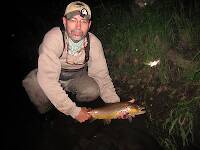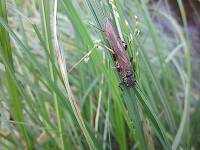
Salmonflies
Pteronarcys californica
The giant Salmonflies of the Western mountains are legendary for their proclivity to elicit consistent dry-fly action and ferocious strikes.
Featured on the forum

I caught this tiny larva without a case, but it seems to key pretty clearly to to Glossosomatidae. From there, the lack of sclerites on the mesonotum points to either Glossosoma or Anagapetus. Although it's difficult to see in a 2D image from the microscope, it's pretty clear in the live 3D view that the pronotum is only excised about 1/3 of its length to accommodate the forecoxa, not 2/3, which points to Glossosoma at Couplet 5 of the Key to Genera of Glossosomatidae Larvae.

Troutnut is a project started in 2003 by salmonid ecologist Jason "Troutnut" Neuswanger to help anglers and
fly tyers unabashedly embrace the entomological side of the sport. Learn more about Troutnut or
support the project for an enhanced experience here.
Strmanglr on Jun 8, 2012June 8th, 2012, 8:40 am EDT
Generally I use dubbing wax when my hands are so dry I can't spin the dubbing well, and so I put it on my hands. Are you all using dubbing wax on the thread to help flies float? Does it make a difference?
Martinlf on Jun 8, 2012June 8th, 2012, 9:32 am EDT
A bit of low tack wax on the fingers is a good trick that I also use sometimes, and I sometimes wax my thread with tacky wax for specific applications, such as touch dubbing, but I don't believe that using wax on the thread makes a big difference in terms of flotation.
"He spread them a yard and a half. 'And every one that got away is this big.'"
--Fred Chappell
--Fred Chappell
Sayfu
Posts: 560
Posts: 560
Sayfu on Aug 13, 2012August 13th, 2012, 12:19 pm EDT
Never heard of the wax adding to floatation, but do use it for touch dubbing like Martiniff posted. I use some cream fly flotant on my fingers often. Greatly assists in application, and flotation getting the cream into the material. Downside?...dubbing wax can discolor your flies sitting in your fly box.
Wbranch on Aug 13, 2012August 13th, 2012, 6:51 pm EDT
"Are you all using dubbing wax on the thread to help flies float?"
You might be missing the point of the use of dubbing wax. When it is used it is to create a sticky base on the thread so dubbing material will adhere to the tying thread. I don't believe anyone who uses wax on their tying thread is doing so to promote fly floatation.
You might be missing the point of the use of dubbing wax. When it is used it is to create a sticky base on the thread so dubbing material will adhere to the tying thread. I don't believe anyone who uses wax on their tying thread is doing so to promote fly floatation.
Catskill fly fisher for fifty-five years.
Allan on Aug 16, 2012August 16th, 2012, 4:07 pm EDT
Use the least amount of wax as possible. I've not heard anyone ever suggest that dubbing wax helps in floatation. However, I will opine that too much wax will be a detriment to floatation because it will add weight to the fly and it will also make the fly a mess. A trick I learned a long time ago. Before tying: Place about 1/2 teaspoon of sugar and about the same amount of baby oil in your palm. Rub your hands all around for about 30 seconds and rinse off with warm water. Pat dry. This will soften your hands, get the burrs out of your skin and smooth it out, and clean your hands so no dirty skin oil gets into the fly. This is especially important with light color dubbed bodies.
Hope this helps. Oh, obviously if you get a chance, get some Wonder Wax and just give 1 swipe to the tying thread before dubbing.
Allan
Hope this helps. Oh, obviously if you get a chance, get some Wonder Wax and just give 1 swipe to the tying thread before dubbing.
Allan
Grubman on Jan 31, 2013January 31st, 2013, 8:09 am EST
Some great tips here. As said the wax is to hold the dubbing on, not for floatation. But are you buying thread that's already waxed? I tried to get some Danville (sp) thread as it's not pre-waxed and the store didn't have it, they only carried Uni-thread which every roll is waxed. This is most important if your bobbin is ceramic. The wax will, as I'm told, clog your bobbin. If you're tying drys get fly floatant, don't apply too much wax when you dub.
Good luck.
Good luck.
Walleye on Feb 7, 2013February 7th, 2013, 2:06 pm EST
Wax can mat the dubbing and wings on a dry fly! If your hands are dry, just keep a small container of water and tip your finger in it and mat off. this allows you to work with the materials and helps with some dubbing. It does not hurt the fly in anyway.
Every trout is a trophy!
Strmanglr on Feb 7, 2013February 7th, 2013, 4:14 pm EST
When tying and putting wax on the thread it never really did much for me for ease of tying.
I go to a stream and fish there all year but in late March/April the state plants trout and I'm constantly putting more floatant on, catching little tikes left and right, and am usually doing dry fly/dropper. So I thought maybe if I waxed the thread ... Wax floats ...
I think I'll just stay away until the locals harvest out the little things, they don't provide a challenge they'll hit a cigarette butt, even those funny smelling ones. Must have a script. Lol.
I go to a stream and fish there all year but in late March/April the state plants trout and I'm constantly putting more floatant on, catching little tikes left and right, and am usually doing dry fly/dropper. So I thought maybe if I waxed the thread ... Wax floats ...
I think I'll just stay away until the locals harvest out the little things, they don't provide a challenge they'll hit a cigarette butt, even those funny smelling ones. Must have a script. Lol.
Quick Reply
Related Discussions
Topic
Replies
Last Reply
10
Jun 29, 2011
by Oldredbarn
by Oldredbarn
18
Feb 19, 2016
by TNEAL
by TNEAL










